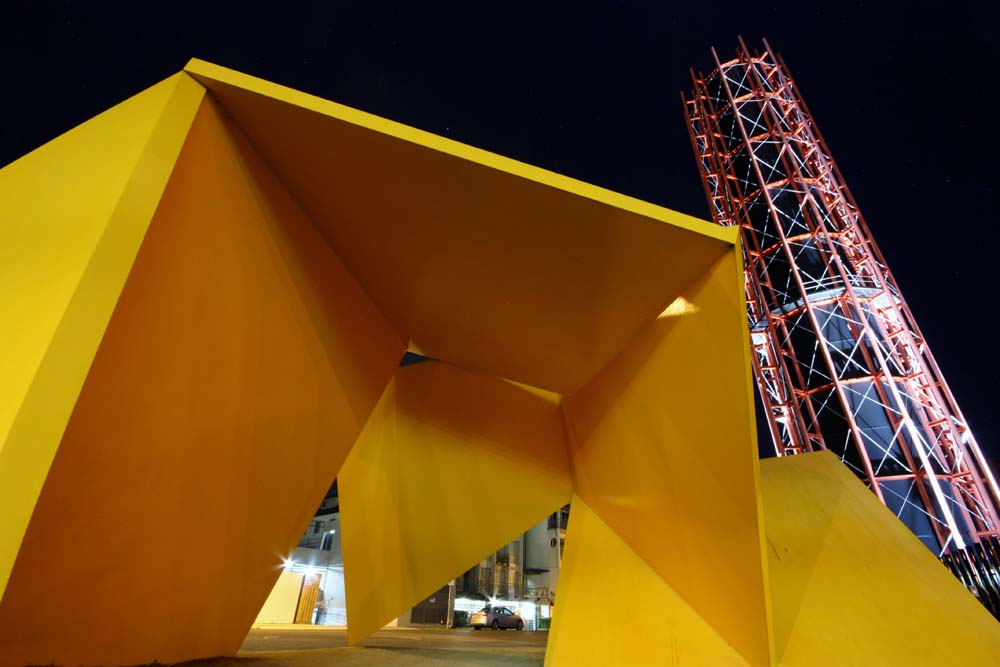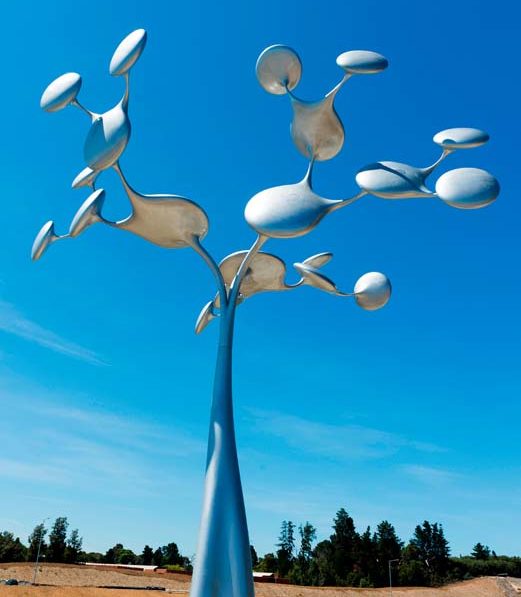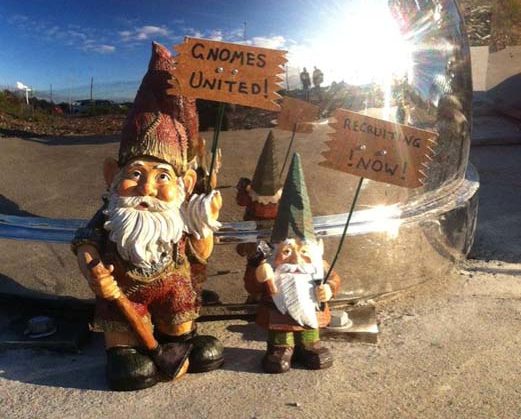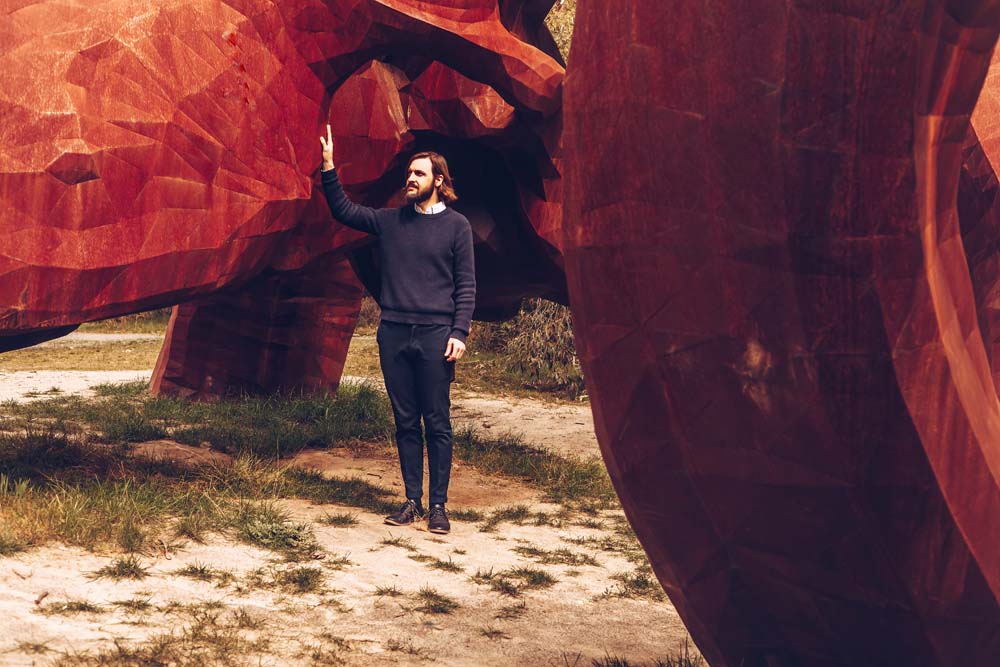Ever since the late ’70’s when Melbourne’s first public art was unveiled, people have had divided opinions on the pieces. It was a yellow contemporary art sculpture called Vault that started all the controversy and earned it the name The Yellow Peril. Forty years on and there is still as much heated debate about public art as we have discovered with the sculptures installed along Peninsula Link. So who are the people behind these sculptures and why are they chosen to be displayed on the main arterial that was opened in 2013?

“The Southern Way McClelland Commission is the program responsible for putting major sculptures at two sites on the Peninsula Link freeway, at the Cranbourne Road and Skye Road exits,” said Simon Lawrie, Balnaves Curator of Australian Sculpture at the McClelland Galley and Sculpture Park. “The sculptures are chosen by a panel of three judges. The judges who chose Gregor Kregar’s gnome were Robert Lindsay, then Director of McClelland Sculpture Park and Gallery, Kirsten Paisley, Director of Shepparton Art Museum, and sculptor Robert Bridgewater. A new panel choose the next works.”
Along Peninsula Link, there are a total of three sculptures at the one time; a permanent installation at the intersection of Eastlink, and two interchangeable works at the other exits.
“The site where the sculpture Panorama Station by Louise Paramor sits marks the interchange between EastLink and Peninsula Link. Panorama Station is a permanent sculpture that was also funded by the Southern Way McClelland Commission,” said Mr Lawrie, who believes it was chosen for its brightness and the fact the artist is an iconic Australian sculptor. “This work is large and bright, and right on the bridge where Peninsula Link starts. It was chosen as Louise is a significant artist in Australia. This work had wide appeal as it was colourful and a real landmark. It is the only permanent installation along the freeway.”
Mr Lawrie says he understands that the sculptures cause great controversy and explains that is part of the process when introducing new art to the public.
“There is always a lot of discussion around the sculpture. People either love it or they hate it. Regardless, they start to think about what art is and it can often initiate a whole new thought process which is great,” said Mr Lawrie. “Depending on the type of work it is, people can either relate to it or not. Like all art, you get out of it what you want. Regardless of whether the sculpture is loved or hated, I think the community always seems to have a sense of ownership over it which is wonderful. And each sculpture really defines the place and the people.”
One of the most popular sculptures to date has been The Tree of Life which was originally installed at the Cranbourne Road exit and replaced by Reflective Lullaby in 2015 which created uproar.

“After The Tree of Life the choice of Reflective Lullaby or the big silver gnome as it is referred to, caused a bit of division in the community. The board who chose this piece loved it as it has a sense of fun, and gnomes are the guardians of the garden. This gnome stands there and guards the community,” said Mr Lawrie.
While some of the community were disgruntled with the replacement sculpture, others took a shine to it, having fun with the quirky character.
“It didn’t take long for people to like it actually, even having fun with it by placing garden gnomes at the base of the sculpture with signs like ‘Gnomes United’ and ‘Recruiting Now’”, said Mr Lawrie telling of how some of the community had embraced the gnome.

“When we install a new piece we create debate. It starts up a conversation about what art is and often introduces people who wouldn’t normally go to galleries to be exposed to this type of sculpture. For some, it has even encouraged them to come to the gallery and see more,” he said.
While Southern Way generously sponsors the pieces of art, McClelland Gallery and Sculpture Park has ownership of them so each piece is taken there at the end of their four year tenure.
“It is a day’s process to install the sculptures and take them down, and we make sure they have the perfect spot to be displayed back at our sculpture park,” said Mr Lawrie. “The Tree of Life is in the front section where people can come and see it from a different perspective. Often we see people lying under it on the grass and looking up at the moving pieces.”
Another sculpture which has been moved and replaced recently is the Skye Road exit sculpture with the official name Rex Australis: The King is dead, long live the King. Most people refer to the more than 7m tall and 14m wide iron sculpture as the Ram’s Head.

“That proved to be the most challenging to install and remove because of the sheer size of the piece. It is in three different interlockable sections and quite a challenge,” said Mr Lawrie. “Now it is back at the sculpture park; it is an incredible piece to get up close to and check out.”
Each work is designed on a large scale to be viewed from cars travelling at the speed limit, with enough time to check them out but not to distract from driving.
“Sculptures on freeways have been around for a long time. In terms of public buildings, it began in America and Russia in the 1930s. They started a percent for art project where it was a requirement with the government that developers had to have a component of public art,” said Mr Lawrie. “It was an attractive part of the proposal from Southern Way that they would use public art projects.”
With Iconoclast replacing the Ram’s Head last year, even more controversy came to a head as the piece is not aesthetically pleasing. However, as Mr Lawrie explains, the motivation of the artist puts the sculpture into new light.
![]()
“Iconoclast by Australian artist Michael Riddle, is in the form of a transmission tower crumbling under the weight of a boulder or meteorite, and was accepted out of around a hundred proposals submitted,” said Mr Lawrie. “The artist created the piece after his parents died to represent the shock and crumbling of his world in a literal emotional representation. Interestingly, it was installed at the same time as the South Australian energy crisis, which was a catalyst for a lot of discussion around sustainability and climate change.”
Each sculpture proposal has to provide a detailed engineers report which addresses all hypothetical issues. Mr Lawrie explains that for the gnome they had to have a backup plan to avoid it being too reflective.
“With Reflective Lullaby being made of stainless steel, there was always the possibility it would be too reflective in the sun. We had a proposal to coat the whole piece with varnish but didn’t end up having to do that,” he said of the sculpture that will be replaced by a new piece next year by artists John Meade and Emily Karanikolopolous with Love Flower. I am very excited about this sculpture and I think people will absolutely love it.”
Love them or hate them, sculptures will keep appearing along Peninsula Link for over 25 years until the year 2037.
“In total there will be 14 sculptures over the years. I think they are important as they can definitely make you think deeply and more long term about aspects of life that you might otherwise just let pass by,” said Mr Lawrie. “Entertainment can change your mood, but art can change the way you see things.”
